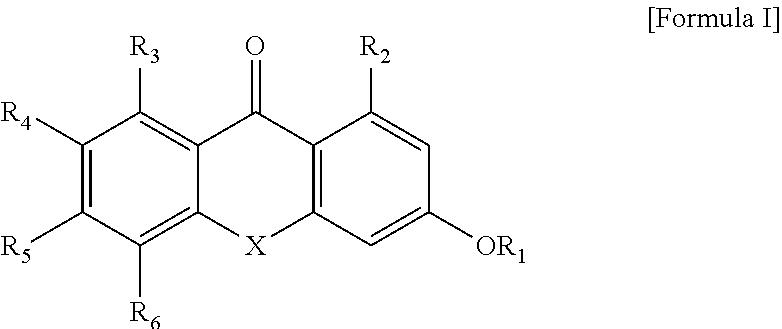Anticancer-aiding compound, method for preparing the same, anticancer-aiding composition containing the same and method for reducing anticancer drug resistance using the same
a technology of anticancer drugs and compounds, applied in the field of anticanceraiding compounds, can solve the problems of no teaching or suggestion regarding the use of xanthone structurally, and achieve the effect of suppressing the growth of cancer and preventing the cellular efflux of an anticancer drug
- Summary
- Abstract
- Description
- Claims
- Application Information
AI Technical Summary
Benefits of technology
Problems solved by technology
Method used
Image
Examples
example 1
Synthesis of 3-(3-chloro-2-hydroxypropoxy)-1-hydroxy-5-methoxy-9H-xanthen-9-one (Compound 1)
Step 1: Synthesis of 1,3-dihydroxy-5-methoxy-9H-xanthen-9-one
[0121]2,3-dimethoxybenzoic acid (0.91 g, 5 mmol), phloroglucinol (0.95 g, 7.5 mmol), ZnCl□ (4.69 g, 30 mmol) and POCl□ (20 mL) were charged to a dry round-bottom flask, followed by stirring at 80° C. for 4 hours. After the reaction was completed, the reaction mixture was cooled to room temperature and was very slowly added to 500 mL of ice water. When the reaction liquid was poured in ice water, ice was added portionwise to prevent overheating. The resulting precipitate was allowed to stand at 4° C. overnight, combined, washed with water and ether, and then dried under reduced pressure to give the title compound (1.22 g, 94.8%) as a reddish brown solid.
[0122]1H-NMR (250 MHz, DMSO-d6) δ 3.96 (s, 3H, C5-OCH3), 6.21 (d, J=2.1 Hz, 1H, C2-H), 6.40 (d, J=2.1 Hz, 1H, C4-H), 7.36 (dd, J=8.0, 7.9 Hz, 1H, C7-H), 7.49 (dd, J=1.3, 8.0 Hz, 1H, C...
example 2
Synthesis of 3-(3-chloro-2-hydroxypropoxy)-1-hydroxy-9H-xanthen-9-one (Compound 2)
Step 1: Synthesis of 1,3-dihydroxy-9H-xanthen-9-one
[0133]Salicylic acid (1.25 g, 9.1 mmol), phloroglucinol (1.26 g, 10 mmol), ZnCl□(3.1 g, 22.8 mmol) and POCl□ (8 mL) were charged to a dry round-bottom flask, and the reaction mixture was stirred at 80° C. for 4 hours. After the reaction was completed, the reaction mixture was cooled to room temperature and was very slowly added to ice water. When the reaction liquid was poured in ice water, ice was added portionwise to prevent overheating. The resulting precipitate was allowed to stand at 4° C. overnight, combined, washed with water and ether, and then dried under reduced pressure to give a reddish brown solid compound (1.94 g, 93%).
[0134]1H-NMR (250 MHz, DMSO-d6) δ 6.21 (d, J=2.0 Hz, 1H, C2-H), 6.40 (d, J=2.0 Hz, 1H, C4-H), 7.45 (dd, J=7.7, 8.1 Hz 1H, C7-H), 7.58 (d, J=8.1 Hz, 1H, C5-H), 7.84 (dd, J=7.7, 7.9 Hz, 1H, C6-H), 8.12 (dd, J=1.3, 7.9 Hz, 1H,...
example 3
Synthesis of 1-hydroxy-5-methoxy-3-(thiiran-2-ylmethoxy)-9H-xanthen-9-one (Compound 3)
[0144]A mixture of 1,3-dihydroxy-5-methoxy-9H-xanthen-9-one (513 mg, 1.99 mmol) prepared in Step 1 of Example 1 and K2CO3 (548 mg, 3.96 mmol) in anhydrous acetone (15 mL) was charged to a dry round-bottom flask, and epichlorohydrin (1.08 g, 9.93 mmol) was added thereto, followed by stirring with reflux at a temperature of 55 to 60° C. for 6 hours. Solid of the reaction mixture was filtered, and the solvent was removed under reduced pressure. The resulting residue was separated and purified by silica gel column chromatography (developing solvent: ethyl acetate:n-hexane=1:1 (v / v)) to give the title compound (104 mg, 15.9%) as a yellow solid.
[0145]m.p. 187° C.; Rf 0.69 (ethyl acetate:n-hexane=1:1 (v / v));
[0146]1H-NMR (200 MHz, CDCl3) δ 2.37 (dd, J=0.8, 5.2 Hz, 1H, C3′-Ha), 2.66 (d, J=5.2 Hz, 1H, C3′-Hb), 3.30-3.34 (m, 1H, C-2′H), 4.01 (dd, J=6.9, 10.4 Hz, 1H, C1′-Ha), 4.04 (s, 3H, C5-OCH3), 4.28 (dd, J...
PUM
| Property | Measurement | Unit |
|---|---|---|
| temperature | aaaaa | aaaaa |
| temperature | aaaaa | aaaaa |
| temperature | aaaaa | aaaaa |
Abstract
Description
Claims
Application Information
 Login to view more
Login to view more - R&D Engineer
- R&D Manager
- IP Professional
- Industry Leading Data Capabilities
- Powerful AI technology
- Patent DNA Extraction
Browse by: Latest US Patents, China's latest patents, Technical Efficacy Thesaurus, Application Domain, Technology Topic.
© 2024 PatSnap. All rights reserved.Legal|Privacy policy|Modern Slavery Act Transparency Statement|Sitemap



